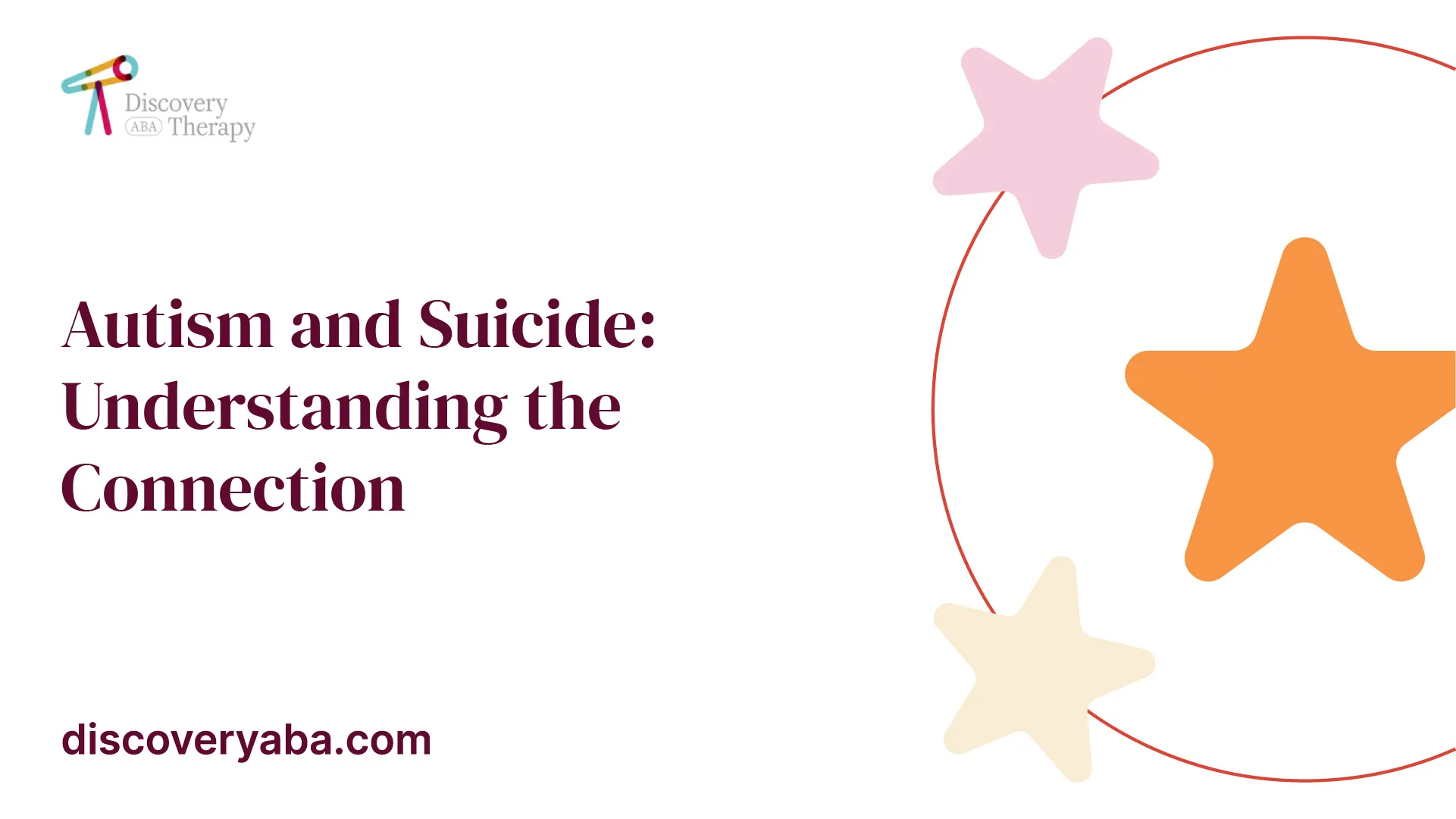Autism and Suicide: Understanding the Connection
Research has shown that individuals with ASD are at a higher risk of suicide than the general population. In this article, we will take a closer look at the connection between autism and suicide, the risk factors involved, and what can be done to prevent it.
.jpeg)
The Connection Between Autism and Suicide
According to a study published in the Journal of the American Academy of Child and Adolescent Psychiatry, individuals with ASD (Autism Spectrum Disorder) are up to three times more likely to attempt suicide than those without the disorder. This is an alarming statistic that highlights the urgent need for greater awareness and understanding of the condition.
The challenges faced by individuals with ASD in social interactions and communication can be overwhelming. These difficulties can lead to feelings of isolation, loneliness, and an inability to connect with others. It is important to recognize that individuals with ASD often have unique needs and may require additional support to help them navigate daily life.
In addition to these challenges, many individuals with ASD also experience co-occurring conditions such as depression, anxiety, and obsessive-compulsive disorder. These conditions can further exacerbate their risk of suicide and must be addressed with the utmost care and attention.
It is crucial that we work to increase awareness and understanding of ASD to help prevent suicide and ensure that individuals with ASD receive the support they need. By providing resources and support to those affected by ASD, we can help to promote a more inclusive and compassionate society. If you or someone you know is struggling with suicidal thoughts, please seek help immediately by calling the National Suicide Prevention Lifeline at 1-800-273-TALK (8255).

Prevalence of Suicide in Individuals with Autism
Studies have found that suicide is a leading cause of premature death among individuals with ASD. In fact, research indicates that the risk of suicide is significantly higher in this population than in the general population. According to a study published in the Journal of Autism and Developmental Disorders, suicide accounts for approximately 30% of all deaths among individuals with ASD.
One reason for the increased risk of suicide among individuals with ASD may be due to difficulties they face in social interactions and communication. These challenges can lead to feelings of isolation, loneliness, and depression, which can increase their risk of suicidal ideation.
It is important to note that while suicide is more prevalent among individuals with ASD, it is not inevitable. With early intervention, appropriate support services, and increased awareness and understanding of ASD, we can work towards preventing suicide and promoting mental health for all individuals. By recognizing the unique needs and challenges faced by those with ASD and providing targeted support, we can help reduce the prevalence of suicide in this population.

Risk Factors for Suicide in Individuals with ASD
Several risk factors have been identified that increase the likelihood of suicide in individuals with ASD. These include:
- History of self-harm or suicidal behavior
- Co-occurring mental health conditions such as depression or anxiety
- Difficulty with social interaction and communication
- Bullying or victimization
- Family history of suicide
It is important to note that not all individuals with ASD will experience suicidal thoughts or behaviors. However, it is crucial to be aware of the risk factors involved and to seek help if any of these risk factors are present.
Preventing Suicide in Individuals with ASD
Preventing suicide in individuals with ASD involves a multifaceted approach that addresses the underlying risk factors. Some strategies that can be helpful include:
- Early intervention and diagnosis of ASD
- Treatment of co-occurring mental health conditions
- Social skills training and therapy to improve communication and social interaction
- Building a supportive network of family, friends, and professionals
- Addressing bullying and victimization
It is important to remember that suicide is preventable, and there is help available for individuals with ASD who may be struggling with suicidal thoughts or behavior. If you or someone you know is experiencing suicidal thoughts or behavior, seek help immediately.
The Impact of Sensory Processing Difficulties on the Risk of Suicide in Individuals with ASD
Sensory processing difficulties are commonly experienced by individuals with ASD and can significantly impact their daily lives. These difficulties can arise from an over or under-sensitivity to sensory stimuli such as sound, touch, and light. Research has shown that sensory processing difficulties can also increase the risk of suicide in individuals with ASD.
The overwhelming experience of sensory overload can lead to feelings of distress, anxiety, and even physical pain. This can result in social isolation, avoidance behaviors, and a reduced quality of life. It is essential to recognize these challenges and provide appropriate support to help individuals with ASD manage their sensory processing difficulties effectively.
Therapies such as occupational therapy and sensory integration therapy have been shown to be effective in managing sensory processing difficulties in individuals with ASD. Early identification and intervention for these challenges may also reduce the risk of suicide.
By understanding the impact of sensory processing difficulties on individuals with ASD, we can develop more comprehensive strategies for suicide prevention. It is crucial that we work towards creating a more inclusive society that provides the necessary support and resources for those affected by ASD.
Early ASD Screening & Suicide Risk
Early screening and identification of ASD is crucial for individuals who are at risk of suicide. Research has shown that early intervention can improve outcomes for individuals with ASD, including reducing the risk of co-occurring mental health conditions such as depression and anxiety.
It is important to recognize the signs and symptoms of ASD in children and adults to facilitate early diagnosis. These signs may include delayed language development, difficulty with social interaction, repetitive behaviors or routines, and sensory processing difficulties.
Individuals who have a family history of ASD or those who display early signs or symptoms should be screened for the disorder. Early identification can help ensure that appropriate interventions are put in place to support individuals with ASD and reduce their risk of suicide.
Screening for ASD can be conducted by healthcare professionals such as pediatricians, psychiatrists, or psychologists. The screening process may involve a comprehensive evaluation of an individual's developmental history, behavior, communication skills, and cognitive abilities.
Early screening and identification can also help to promote greater awareness and understanding of ASD within families, schools, and communities. This increased awareness can lead to earlier recognition of the challenges faced by individuals with ASD and provide opportunities for support and intervention.
In summary, early screening and identification of ASD is critical for individuals at risk of suicide. By identifying ASD early on, we can ensure that appropriate support is provided to reduce the risk of co-occurring mental health conditions such as depression or anxiety. It is essential that we work towards increasing awareness about the importance of early screening among healthcare professionals, families, schools, and communities.
Recognizing and Treating Suicidal Thoughts in People with Autism Spectrum Disorder (ASD)
As healthcare providers, it is essential to be aware of the increased risk of suicide in individuals with ASD and to take steps to identify and address suicidal ideation during routine care visits. Here are some strategies that can be helpful:
Screening for Suicide Risk
Healthcare providers should screen for suicide risk during routine care visits. This can involve asking questions about an individual's thoughts and feelings related to suicide, as well as assessing for any risk factors such as a history of self-harm or suicidal behavior.
Screening tools such as the Columbia-Suicide Severity Rating Scale (C-SSRS) or the Autism Spectrum Quotient (AQ) can be used to help identify individuals who may be at higher risk of suicide.
Providing Education and Resources
Healthcare providers should provide education and resources on suicide prevention to individuals with ASD and their families. This can include information on warning signs, risk factors, and strategies for preventing suicide.
Resources such as crisis hotlines, support groups, and mental health services should also be provided to ensure that individuals with ASD have access to the support they need.
Developing a Safety Plan
Developing a safety plan in collaboration with the individual with ASD and their family can help prevent suicidal behavior. The safety plan should include strategies for managing suicidal thoughts or behaviors, as well as emergency contact information.
The safety plan should be reviewed regularly during routine care visits to ensure that it remains up-to-date and relevant.
Referring for Mental Health Services
Individuals with ASD who are at increased risk of suicide should be referred for mental health services. This may include therapy, medication management, or other interventions depending on the individual's needs.
It is important to work collaboratively with mental health professionals to ensure that individuals with ASD receive appropriate care that addresses both their autism-related challenges and co-occurring mental health conditions that may increase their risk of suicide.
By implementing these strategies, healthcare providers can better identify and address suicidal ideation in individuals with ASD during routine care visits. It is essential to take a proactive approach to suicide prevention and ensure that individuals with ASD have access to the support and resources they need.
The Effectiveness of Peer Support Groups in Reducing the Risk of Suicide in Individuals with ASD
Peer support groups can be an effective way to reduce the risk of suicide in individuals with ASD. These groups provide a safe and supportive environment for individuals with ASD to connect with others who share similar experiences and challenges.
In peer support groups, individuals with ASD can share their thoughts and feelings without judgment, receive emotional support, and learn coping strategies from others who have gone through similar experiences. This can help to reduce feelings of isolation and loneliness and increase feelings of belonging and connection.
Research has shown that peer support groups can improve mental health outcomes for individuals with ASD, including reducing symptoms of depression and anxiety. Additionally, participation in peer support groups has been associated with a decreased risk of suicidal ideation.
It is important to note that not all peer support groups are created equal. It is crucial to find a group that is specifically designed for individuals with ASD and facilitated by trained professionals who understand the unique needs and challenges faced by this population.
By providing access to peer support groups as part of a comprehensive approach to suicide prevention, we can help reduce the risk of suicide in individuals with ASD while promoting greater social inclusion and overall well-being.
FAQs
Is suicide more common among individuals with ASD than in the general population?
Yes, research has shown that suicide is a leading cause of premature death among individuals with ASD. Studies indicate that the risk of suicide is significantly higher in this population than in the general population.
What are some warning signs of suicidal ideation in individuals with ASD?
Warning signs of suicidal ideation in individuals with ASD may include talking about death or suicide, expressing feelings of hopelessness or worthlessness, withdrawing from social activities or relationships, and engaging in self-harm behaviors.
How can I help someone with ASD who is experiencing suicidal thoughts or behavior?
If you know someone with ASD who is experiencing suicidal thoughts or behavior, it is important to take their concerns seriously and seek professional help immediately. Encourage them to speak with a mental health professional or contact a crisis hotline for support.
Can sensory processing difficulties increase the risk of suicide in individuals with ASD?
Yes, research has shown that sensory processing difficulties can increase the risk of suicide in individuals with ASD. These challenges can lead to feelings of distress, anxiety, and physical pain. It is essential to recognize these difficulties and provide appropriate support to help individuals manage them effectively.
How can I reduce my risk of suicide if I have ASD?
If you have ASD and are experiencing suicidal thoughts or behavior, it is crucial to seek professional help immediately. Participating in therapies such as occupational therapy and sensory integration therapy can also be helpful for managing sensory processing difficulties that may contribute to suicidal ideation. Building a supportive network of family, friends, and professionals can also provide valuable emotional support during difficult times.
Conclusion
The connection between autism and suicide is a complex issue that requires greater awareness and understanding. Individuals with ASD are at a higher risk of suicide due to the challenges they face in social interaction and communication, as well as co-occurring mental health conditions. Preventing suicide in individuals with ASD involves a multifaceted approach that addresses the underlying risk factors. With early intervention, treatment, and support, suicide can be prevented in individuals with ASD.
Sources
Does Your Child Have An Autism Diagnosis?
Learn More About How ABA Therapy Can Help
Find More Articles
Contact us
North Carolina, Nevada, Utah, Virginia
New Hampshire, Maine
Arizona, Colorado, Georgia, New Mexico, Oklahoma, Texas
.avif)




































































































